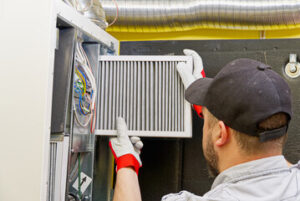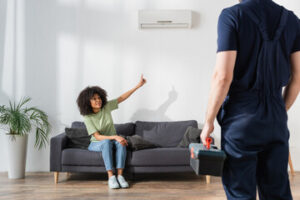If you are not getting heat in all parts of your home, there could be a problem with the air flow or your ducts. If this is the case, it will require a professional to resolve. First, check your thermostat setting. It may be set incorrectly. Next, try adjusting it up or down a few degrees.

If your breaker keeps tripping, it’s likely that there is a problem with one or more appliances. Unless the circuit is temporarily overloaded, a professional should look at the problem before you attempt any DIY fixes.
Figure out which room or rooms the breaker controls. Then, unplug all the devices and appliances in that area. This will help you narrow down the source of the problem. If you see that a specific appliance trips the breaker repeatedly, try plugging it into a different outlet in that room on a different circuit. If it doesn’t trip the breaker, the issue may be with that outlet or switch instead of the equipment itself.
A tripped circuit breaker is usually caused by having too many devices on the same circuit. It can also be caused by a bad cord or plug, or a short circuit in a receptacle, switch, or fixture. If the breaker resets itself but continues to trip, it’s time to call in an electrician.
In homes with fuse boxes (as opposed to breaker panels), the process is slightly different. A fuse is made up of metal strips encased in glass, and it melts when there’s too much power. This is meant to break the circuit if there’s an overload, and it acts as a safety measure against fires.
If a fuse is blown, you’ll need to replace it with a new one. These can be found at any hardware store, but be sure to buy a replacement with the same amperage rating as the old one.
If you’re comfortable opening up your electrical panel, you can usually reset a tripped breaker by moving the switch to the off position and then back to on. Be careful not to move it to the middle position, which could be dangerous and may lead to another breaker trip. Be sure to shut off the power at the main breaker before doing this. If you’re not comfortable working on your home’s electrical system, it’s a good idea to call an electrician for safe and effective repair work.
Pilot Light Will Not Stay Lit
Your furnace’s system depends on the pilot light to stay lit. If it does not, the whole system is affected. It can be a shallow problem or an underlying issue, but either way, it needs to be fixed. A professional should handle the repairs to ensure safety and efficiency.
Depending on your style of gas furnace, the ignition system is controlled by a few different parts. The thermostat calls for heat, the draft inducer fan kicks in to pull air through the furnace, the gas valve opens to move gas into the pilot burner, an electronic spark ignites the gas, and a flame sensor tells the gas valve that the pilot light is lit. If the thermocouple or flame sensor is malfunctioning, the system will shut down because it can’t sense that the pilot is lit.
The best way to diagnose an issue with your gas furnace is to consult the manual that came with it. This should contain specific instructions for relighting the pilot, and it’s a better guide than general guides found online. It’s also important to turn off the power and gas supply to the furnace before starting any work. This will help prevent accidental damage to the equipment and possible injuries to yourself or others.
It is not uncommon for a pilot light to flicker or go out. This is because the tip of the pilot light can become corroded with soot and stop gas flow to it. If this is the case, a toothbrush can be used to scrub the tip of the pilot light and clean it. Additionally, the thermocouple can sometimes get bent. This causes it to not be in contact with the flame, which causes the gas valve to close.
The thermocouple can be repositioned by hand, though this should only be done with extreme caution. It’s a good idea to ask an experienced professional to do this as it can be complicated and dangerous. If the thermocouple or flame sensor cannot be repositioned, it may need to be replaced entirely. This is a part that will need to be replaced by a professional, as it is an essential safety component.
Pilot Light Is Flickering Yellow
If your pilot light is flickering yellow, the first thing you should do is make sure the breaker or fuse that powers the furnace has not been tripped. Then, switch the thermostat to the fan-only or auto position. Ensure that the gas valve is set to the on position.
Next, check the pilot orifice for a clog and clean it with a piece of wire. After doing so, the pilot flame should return to a blue color. If not, the problem may be more serious and you will need to consult your Carrier furnace manual.
It is also possible that the igniter fails or there is not enough gas flowing to the pilot light. This could be caused by a dirty tube that requires cleaning with something abrasive. In addition, a broken thermocouple can also cause the pilot light to flicker. In this case, you will need to repair or replace the device.
Another reason for a yellow blinking light is an overloaded blower motor. This is most often a sign of a belt that needs to be replaced. Consult your furnace manual for specific instructions on replacing the belt and how to relight the pilot light.
If the pilot light blinks yellow, it means there is a serious problem with your furnace and that you should contact a professional furnace maintenance company right away. This issue could be dangerous and can cause carbon monoxide poisoning, so it is important to get the problem resolved right away.
Regular maintenance will prevent many of the problems that can lead to a yellow blinking light. A technician will perform a variety of checks and repairs that will keep your furnace running smoothly and efficiently. They will check for a number of problems, including clogged vents and improper airflow, as well as inspecting and servicing the dozens of parts and subsystems that comprise your heating system. They will also look for signs of a potential electrical problem, such as loose connections or faulty components that can trigger a yellow flashing light and affect your comfort.
Burner Flame Is Yellow or Orange
If your furnace is producing a yellow or orange flame, it is a sign that it needs to be cleaned or repaired. This is a serious issue because it can indicate that your furnace is not combusting gas and oxygen properly, which can result in carbon monoxide poisoning. Carbon monoxide is an odorless, colorless gas that can cause nausea, headaches, and even death. It is important to have this problem fixed as soon as possible.
The flames on your natural gas burner should always be blue, with small traces of other colors from time to time. Anything other than this should be a cause for concern and requires the attention of a professional heating technician as soon as possible. A yellow or orange flame means that your furnace is not combusting the fuel and air properly, which can lead to wasted energy and expensive heating bills.
One common reason that your furnace’s flame may be turning orange is because of dirt build-up. When a furnace is dirty, it cannot properly combust the fuel and air to create heat and won’t burn off any of the extra exhaust. Another sign of a dirty furnace is a burning smell that comes from the unit and doesn’t disperse after a few minutes.
Another common cause for a yellow or orange flame is that there is not enough oxygen in the gas to ignite and combust it. This could be due to a dirty or clogged burner or a faulty blower. In this case, you should shut off your furnace immediately and call a specialist to check it out.
If you have tried turning the furnace breaker back on and it is still not working, try checking the main gas line to see if it is turned off. If the switch is off, it will need to be replaced before your furnace can work again.
Having a gas furnace that is not functioning correctly can make it difficult to keep your home comfortable and cozy. Ignoring these issues will only waste money on heating your home and can lead to dangerous problems such as a carbon monoxide leak. If you have any questions about your furnace or if you notice that the flame is not blue, contact the experts at LCU to schedule a heating repair service.
